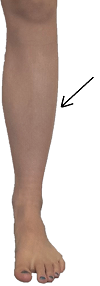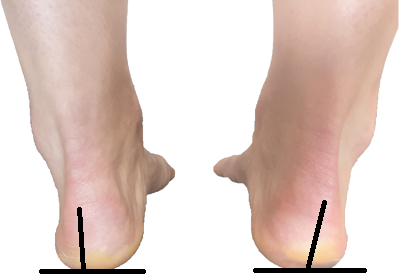

Peroneal Muscle Pain
What is Peroneal Muscle Pain?
Peroneal muscle pain occurs at the peroneal muscle, which is the term for the group of muscles on the outside of the lower leg. Pain in this area can be confused with shin splints, which is pain on the inside of the lower leg/shin. This pain has been casually called “outside shin splits”. One of the main functions of the peroneal muscle is to prevent the ankle from rolling outwards.
When the peroneal muscle is overworked or injured, pain can develop here.
Causes of Peroneal Muscle Pain
Mechanics

Walking on the outside of the foot causes the peroneal muscle to overwork. This may be due to a high arch and/or supination (rolling out) at the heel. Another reason for walking on the outside of the foot can be due to pain compensation. If there is pain while walking on the inside of the foot, you can end up walking on the outside of the foot consciously or unconsciously.
Be aware that your running form may different than walking, which would put a different kind of strain on the muscles.
Injury
A sudden injury to the peroneal muscle typically happens at the peroneal tendon. With an inversion ankle injury, where you roll an ankle by landing on the outside of the foot, the peroneal muscle attempts to correct the foot by suddenly activating. When this occurs, a peroneal tendon attachment to the bone can pull suddenly and tear fully or slightly.
What will I feel and see?
When the peroneal muscles are overworked, you may experience pain or tightness on the outside of the lower leg. This can be while walking or while applying pressure to the affected area.
If this pain is coming from the feet, it may be visibly seen. Look for the heel rolling out or excessive wear on the outside of the shoes.
Pedorthic Treatments/Prevention
Orthotics
Orthotics help to support the foot and reduce strain to the peroneal muscle. If this strain occurs due to a high arch or supination at the heel, the orthotic device helps to push the foot in and release strain at the peroneal muscle. If the strain occurs due to a compensation from pain, the pain must be dealt with to prevent this compensation. If the pain is due to a collapse of the arch, the orthotic device supports the foot to prevent the need for excessive compensation.
In the case of a sudden injury, the mechanics of the foot may not have caused the injury, but may play a factor in the recovery. If the peroneal muscle already works harder than normal, this can hinder the recovery process.
Footwear
Wearing the proper shoes is important in the treatment and prevention of peroneal muscle pain. Shoes can easily push your feet out of alignment if the shoes are not appropriate.
If the feet already shift outwards slightly, wearing a soft shoe can exaggerate this motion and create strain to the peroneal muscles.
Running shoes have different types of support such as stability and neutral. Stability runners are great for overpronators without orthotics, or for those who need additional support with their orthotics. When these stability runners are not recommended, is when the shoe overcorrects the foot or for those who supinate. If the foot is already in an appropriate position, through an orthotic or naturally, a stability runner can push the foot even further outwards, straining the peroneal muscle.
Another important factor to consider are the age of your shoes. Over time, the midsole starts to wear down and can push the foot outwards excessively. This can be through compression at the midsole or by the sole wearing down on the outside. To determine if your shoe is pushing you excessively outwards, place the shoes on a level surface and look at the heels. The heels should be perpendicular to the ground. If you have someone to look for you, this test can also be done standing while wearing the shoes.
If it sounds like a condition you have, or you would like more information, feel free to contact us!

You must be logged in to post a comment.